Project on Prevention of Obesity in Older People in Healthcare Centers
VerifiedAdded on 2023/01/13
|23
|9292
|60
Project
AI Summary
This project addresses the critical issue of obesity prevention among older adults within healthcare centers and home care environments. The introduction highlights obesity as a growing health concern, emphasizing its impact on physical and mental health, and its prevalence in the UK. The project aims to identify the causes and consequences of obesity in older people and to justify the main causes behind prevention of obesity in older people, with objectives including identifying the causes and consequences of obesity, and justifying prevention strategies. The literature review explores the increasing prevalence of obesity among older adults, the causes including genetic, environmental and sociological factors, and other contributing factors such as hormonal changes and associated health conditions. The project outlines the methodology, risk management, success factors, and leadership and management theories relevant to implementing and managing the project. The project targets older adults aged 50-70, focusing on intervention strategies, healthcare practices, and awareness programs to mitigate obesity and improve health outcomes. The project is designed to support better health management and control of older people's health over time.
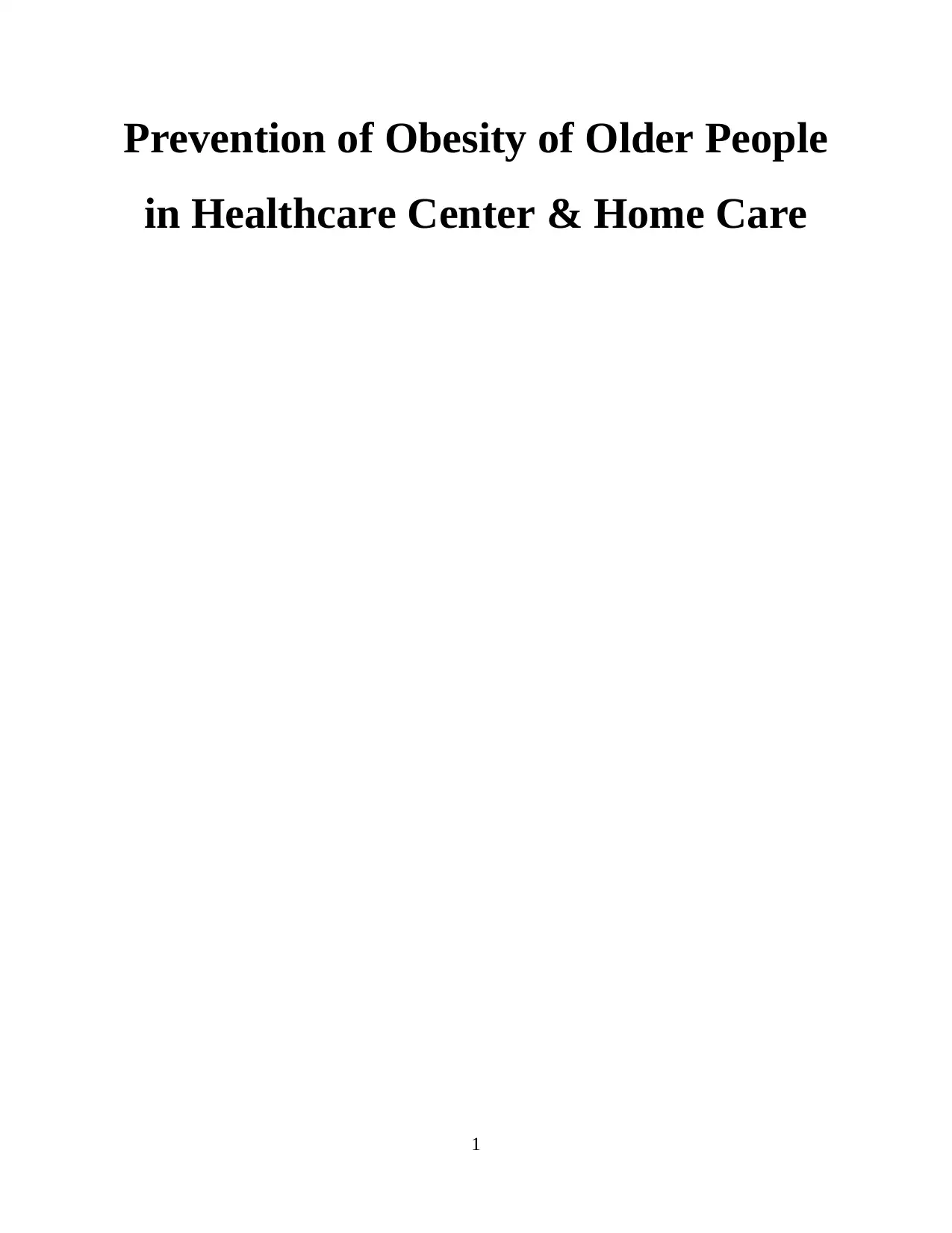
Prevention of Obesity of Older People
in Healthcare Center & Home Care
1
in Healthcare Center & Home Care
1
Paraphrase This Document
Need a fresh take? Get an instant paraphrase of this document with our AI Paraphraser
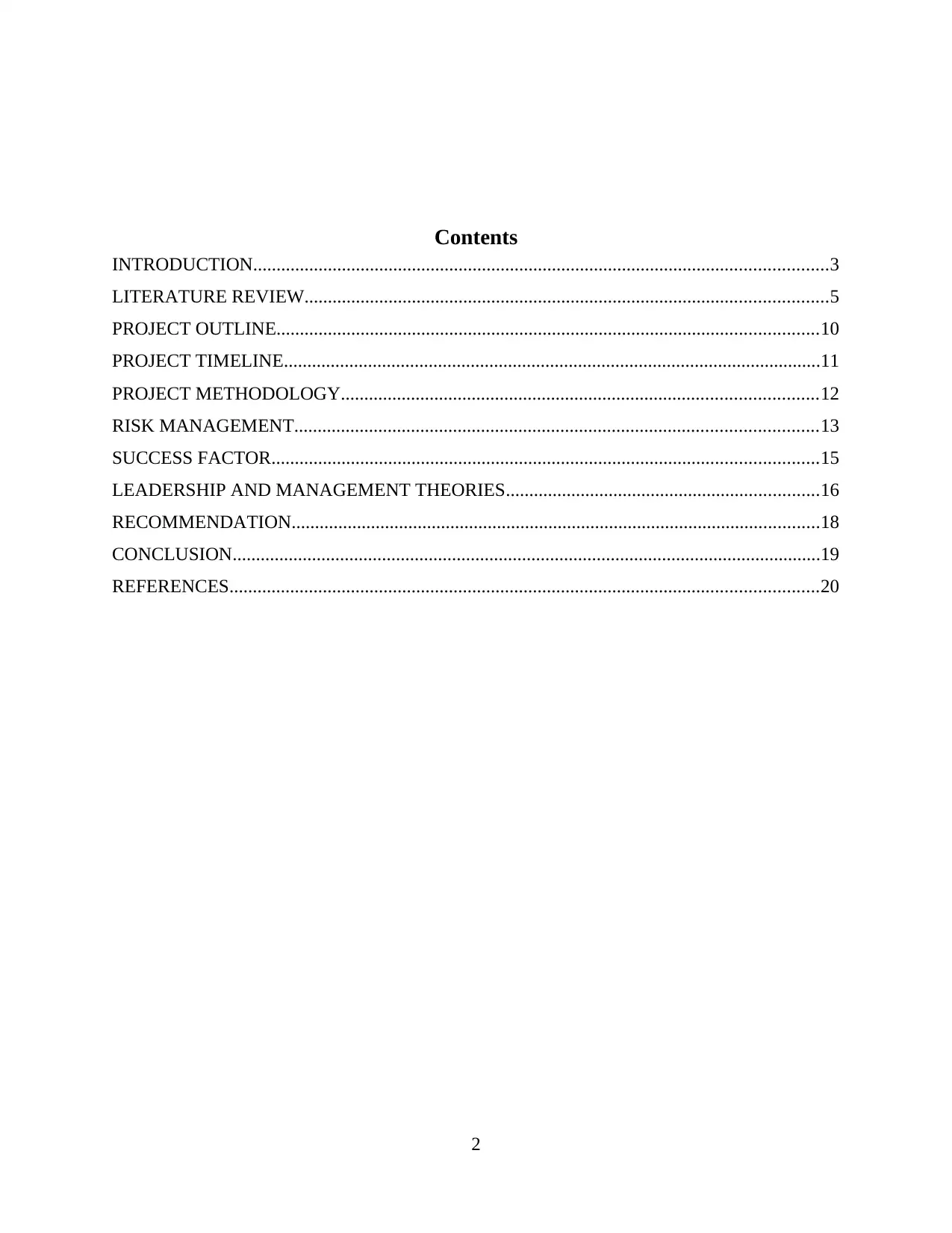
Contents
INTRODUCTION...........................................................................................................................3
LITERATURE REVIEW................................................................................................................5
PROJECT OUTLINE....................................................................................................................10
PROJECT TIMELINE...................................................................................................................11
PROJECT METHODOLOGY......................................................................................................12
RISK MANAGEMENT................................................................................................................13
SUCCESS FACTOR.....................................................................................................................15
LEADERSHIP AND MANAGEMENT THEORIES...................................................................16
RECOMMENDATION.................................................................................................................18
CONCLUSION..............................................................................................................................19
REFERENCES..............................................................................................................................20
2
INTRODUCTION...........................................................................................................................3
LITERATURE REVIEW................................................................................................................5
PROJECT OUTLINE....................................................................................................................10
PROJECT TIMELINE...................................................................................................................11
PROJECT METHODOLOGY......................................................................................................12
RISK MANAGEMENT................................................................................................................13
SUCCESS FACTOR.....................................................................................................................15
LEADERSHIP AND MANAGEMENT THEORIES...................................................................16
RECOMMENDATION.................................................................................................................18
CONCLUSION..............................................................................................................................19
REFERENCES..............................................................................................................................20
2
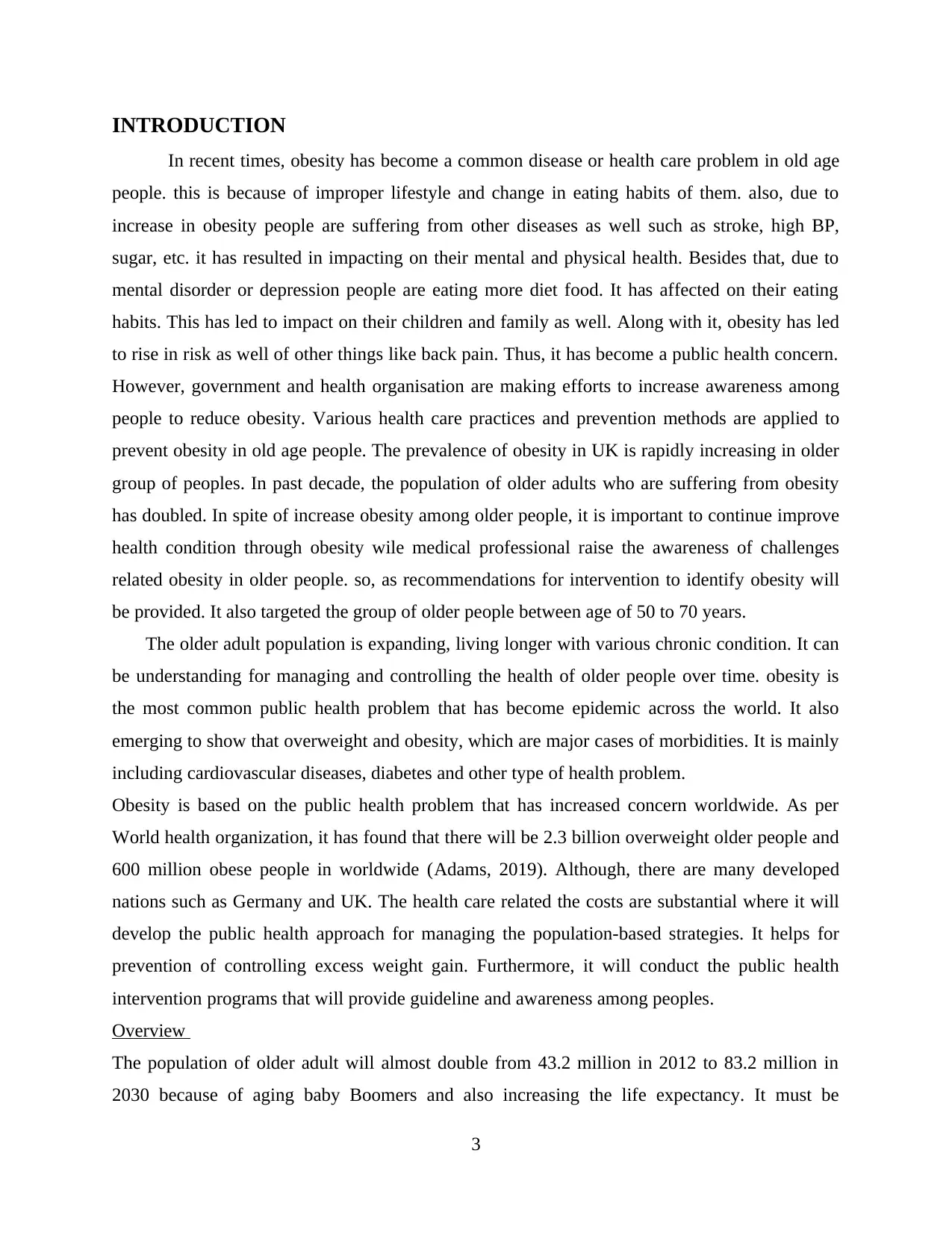
INTRODUCTION
In recent times, obesity has become a common disease or health care problem in old age
people. this is because of improper lifestyle and change in eating habits of them. also, due to
increase in obesity people are suffering from other diseases as well such as stroke, high BP,
sugar, etc. it has resulted in impacting on their mental and physical health. Besides that, due to
mental disorder or depression people are eating more diet food. It has affected on their eating
habits. This has led to impact on their children and family as well. Along with it, obesity has led
to rise in risk as well of other things like back pain. Thus, it has become a public health concern.
However, government and health organisation are making efforts to increase awareness among
people to reduce obesity. Various health care practices and prevention methods are applied to
prevent obesity in old age people. The prevalence of obesity in UK is rapidly increasing in older
group of peoples. In past decade, the population of older adults who are suffering from obesity
has doubled. In spite of increase obesity among older people, it is important to continue improve
health condition through obesity wile medical professional raise the awareness of challenges
related obesity in older people. so, as recommendations for intervention to identify obesity will
be provided. It also targeted the group of older people between age of 50 to 70 years.
The older adult population is expanding, living longer with various chronic condition. It can
be understanding for managing and controlling the health of older people over time. obesity is
the most common public health problem that has become epidemic across the world. It also
emerging to show that overweight and obesity, which are major cases of morbidities. It is mainly
including cardiovascular diseases, diabetes and other type of health problem.
Obesity is based on the public health problem that has increased concern worldwide. As per
World health organization, it has found that there will be 2.3 billion overweight older people and
600 million obese people in worldwide (Adams, 2019). Although, there are many developed
nations such as Germany and UK. The health care related the costs are substantial where it will
develop the public health approach for managing the population-based strategies. It helps for
prevention of controlling excess weight gain. Furthermore, it will conduct the public health
intervention programs that will provide guideline and awareness among peoples.
Overview
The population of older adult will almost double from 43.2 million in 2012 to 83.2 million in
2030 because of aging baby Boomers and also increasing the life expectancy. It must be
3
In recent times, obesity has become a common disease or health care problem in old age
people. this is because of improper lifestyle and change in eating habits of them. also, due to
increase in obesity people are suffering from other diseases as well such as stroke, high BP,
sugar, etc. it has resulted in impacting on their mental and physical health. Besides that, due to
mental disorder or depression people are eating more diet food. It has affected on their eating
habits. This has led to impact on their children and family as well. Along with it, obesity has led
to rise in risk as well of other things like back pain. Thus, it has become a public health concern.
However, government and health organisation are making efforts to increase awareness among
people to reduce obesity. Various health care practices and prevention methods are applied to
prevent obesity in old age people. The prevalence of obesity in UK is rapidly increasing in older
group of peoples. In past decade, the population of older adults who are suffering from obesity
has doubled. In spite of increase obesity among older people, it is important to continue improve
health condition through obesity wile medical professional raise the awareness of challenges
related obesity in older people. so, as recommendations for intervention to identify obesity will
be provided. It also targeted the group of older people between age of 50 to 70 years.
The older adult population is expanding, living longer with various chronic condition. It can
be understanding for managing and controlling the health of older people over time. obesity is
the most common public health problem that has become epidemic across the world. It also
emerging to show that overweight and obesity, which are major cases of morbidities. It is mainly
including cardiovascular diseases, diabetes and other type of health problem.
Obesity is based on the public health problem that has increased concern worldwide. As per
World health organization, it has found that there will be 2.3 billion overweight older people and
600 million obese people in worldwide (Adams, 2019). Although, there are many developed
nations such as Germany and UK. The health care related the costs are substantial where it will
develop the public health approach for managing the population-based strategies. It helps for
prevention of controlling excess weight gain. Furthermore, it will conduct the public health
intervention programs that will provide guideline and awareness among peoples.
Overview
The population of older adult will almost double from 43.2 million in 2012 to 83.2 million in
2030 because of aging baby Boomers and also increasing the life expectancy. It must be
3
⊘ This is a preview!⊘
Do you want full access?
Subscribe today to unlock all pages.

Trusted by 1+ million students worldwide
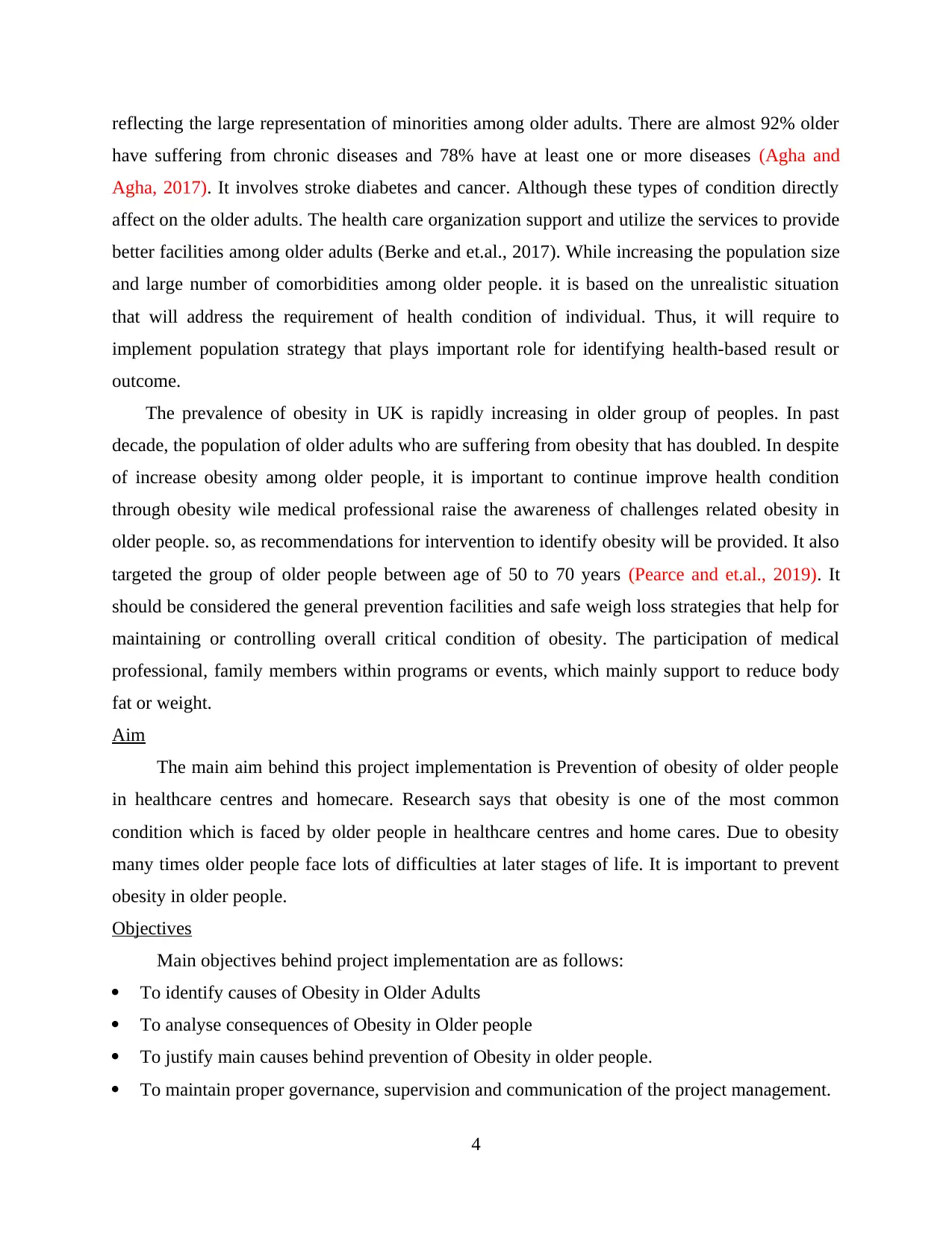
reflecting the large representation of minorities among older adults. There are almost 92% older
have suffering from chronic diseases and 78% have at least one or more diseases (Agha and
Agha, 2017). It involves stroke diabetes and cancer. Although these types of condition directly
affect on the older adults. The health care organization support and utilize the services to provide
better facilities among older adults (Berke and et.al., 2017). While increasing the population size
and large number of comorbidities among older people. it is based on the unrealistic situation
that will address the requirement of health condition of individual. Thus, it will require to
implement population strategy that plays important role for identifying health-based result or
outcome.
The prevalence of obesity in UK is rapidly increasing in older group of peoples. In past
decade, the population of older adults who are suffering from obesity that has doubled. In despite
of increase obesity among older people, it is important to continue improve health condition
through obesity wile medical professional raise the awareness of challenges related obesity in
older people. so, as recommendations for intervention to identify obesity will be provided. It also
targeted the group of older people between age of 50 to 70 years (Pearce and et.al., 2019). It
should be considered the general prevention facilities and safe weigh loss strategies that help for
maintaining or controlling overall critical condition of obesity. The participation of medical
professional, family members within programs or events, which mainly support to reduce body
fat or weight.
Aim
The main aim behind this project implementation is Prevention of obesity of older people
in healthcare centres and homecare. Research says that obesity is one of the most common
condition which is faced by older people in healthcare centres and home cares. Due to obesity
many times older people face lots of difficulties at later stages of life. It is important to prevent
obesity in older people.
Objectives
Main objectives behind project implementation are as follows:
To identify causes of Obesity in Older Adults
To analyse consequences of Obesity in Older people
To justify main causes behind prevention of Obesity in older people.
To maintain proper governance, supervision and communication of the project management.
4
have suffering from chronic diseases and 78% have at least one or more diseases (Agha and
Agha, 2017). It involves stroke diabetes and cancer. Although these types of condition directly
affect on the older adults. The health care organization support and utilize the services to provide
better facilities among older adults (Berke and et.al., 2017). While increasing the population size
and large number of comorbidities among older people. it is based on the unrealistic situation
that will address the requirement of health condition of individual. Thus, it will require to
implement population strategy that plays important role for identifying health-based result or
outcome.
The prevalence of obesity in UK is rapidly increasing in older group of peoples. In past
decade, the population of older adults who are suffering from obesity that has doubled. In despite
of increase obesity among older people, it is important to continue improve health condition
through obesity wile medical professional raise the awareness of challenges related obesity in
older people. so, as recommendations for intervention to identify obesity will be provided. It also
targeted the group of older people between age of 50 to 70 years (Pearce and et.al., 2019). It
should be considered the general prevention facilities and safe weigh loss strategies that help for
maintaining or controlling overall critical condition of obesity. The participation of medical
professional, family members within programs or events, which mainly support to reduce body
fat or weight.
Aim
The main aim behind this project implementation is Prevention of obesity of older people
in healthcare centres and homecare. Research says that obesity is one of the most common
condition which is faced by older people in healthcare centres and home cares. Due to obesity
many times older people face lots of difficulties at later stages of life. It is important to prevent
obesity in older people.
Objectives
Main objectives behind project implementation are as follows:
To identify causes of Obesity in Older Adults
To analyse consequences of Obesity in Older people
To justify main causes behind prevention of Obesity in older people.
To maintain proper governance, supervision and communication of the project management.
4
Paraphrase This Document
Need a fresh take? Get an instant paraphrase of this document with our AI Paraphraser
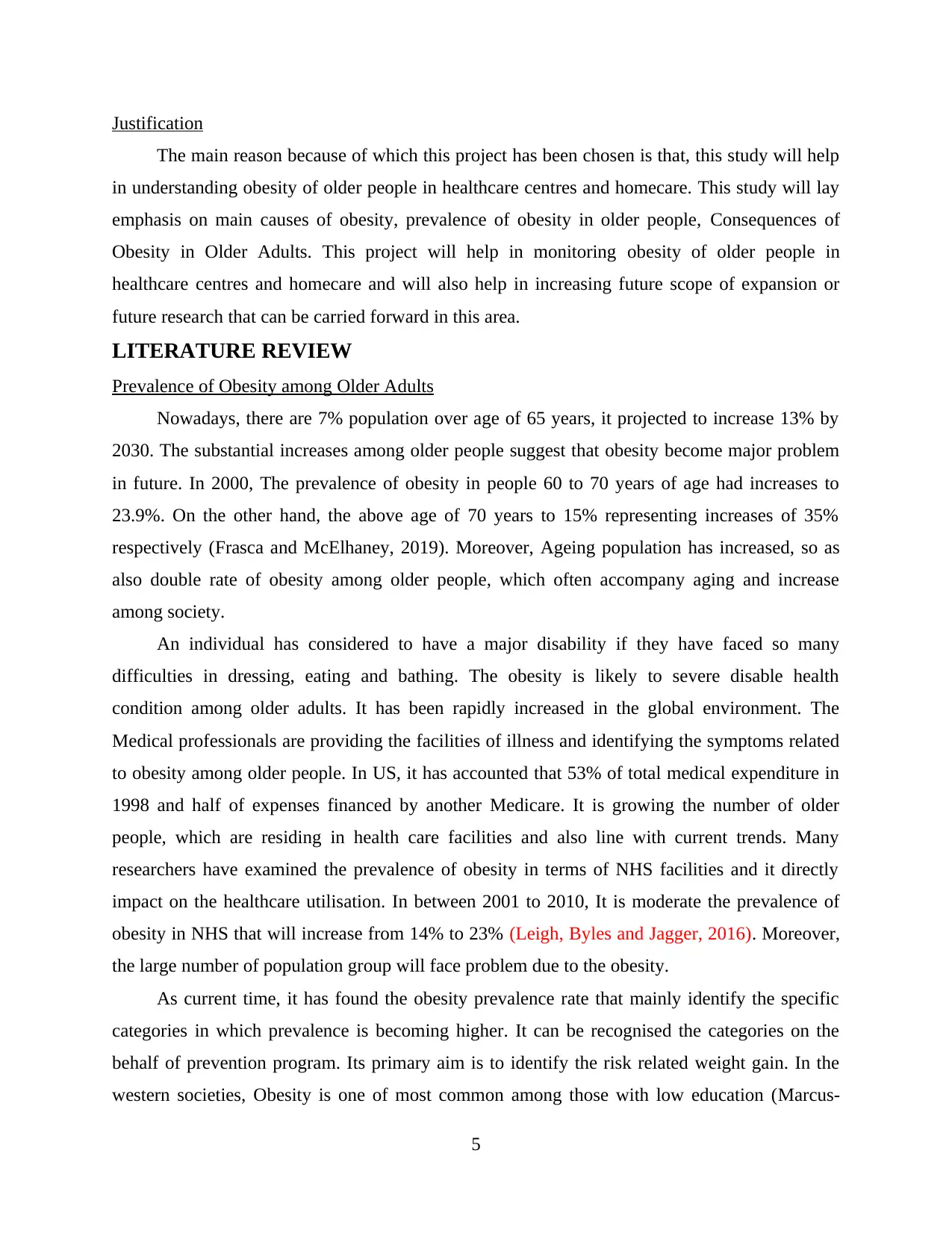
Justification
The main reason because of which this project has been chosen is that, this study will help
in understanding obesity of older people in healthcare centres and homecare. This study will lay
emphasis on main causes of obesity, prevalence of obesity in older people, Consequences of
Obesity in Older Adults. This project will help in monitoring obesity of older people in
healthcare centres and homecare and will also help in increasing future scope of expansion or
future research that can be carried forward in this area.
LITERATURE REVIEW
Prevalence of Obesity among Older Adults
Nowadays, there are 7% population over age of 65 years, it projected to increase 13% by
2030. The substantial increases among older people suggest that obesity become major problem
in future. In 2000, The prevalence of obesity in people 60 to 70 years of age had increases to
23.9%. On the other hand, the above age of 70 years to 15% representing increases of 35%
respectively (Frasca and McElhaney, 2019). Moreover, Ageing population has increased, so as
also double rate of obesity among older people, which often accompany aging and increase
among society.
An individual has considered to have a major disability if they have faced so many
difficulties in dressing, eating and bathing. The obesity is likely to severe disable health
condition among older adults. It has been rapidly increased in the global environment. The
Medical professionals are providing the facilities of illness and identifying the symptoms related
to obesity among older people. In US, it has accounted that 53% of total medical expenditure in
1998 and half of expenses financed by another Medicare. It is growing the number of older
people, which are residing in health care facilities and also line with current trends. Many
researchers have examined the prevalence of obesity in terms of NHS facilities and it directly
impact on the healthcare utilisation. In between 2001 to 2010, It is moderate the prevalence of
obesity in NHS that will increase from 14% to 23% (Leigh, Byles and Jagger, 2016). Moreover,
the large number of population group will face problem due to the obesity.
As current time, it has found the obesity prevalence rate that mainly identify the specific
categories in which prevalence is becoming higher. It can be recognised the categories on the
behalf of prevention program. Its primary aim is to identify the risk related weight gain. In the
western societies, Obesity is one of most common among those with low education (Marcus-
5
The main reason because of which this project has been chosen is that, this study will help
in understanding obesity of older people in healthcare centres and homecare. This study will lay
emphasis on main causes of obesity, prevalence of obesity in older people, Consequences of
Obesity in Older Adults. This project will help in monitoring obesity of older people in
healthcare centres and homecare and will also help in increasing future scope of expansion or
future research that can be carried forward in this area.
LITERATURE REVIEW
Prevalence of Obesity among Older Adults
Nowadays, there are 7% population over age of 65 years, it projected to increase 13% by
2030. The substantial increases among older people suggest that obesity become major problem
in future. In 2000, The prevalence of obesity in people 60 to 70 years of age had increases to
23.9%. On the other hand, the above age of 70 years to 15% representing increases of 35%
respectively (Frasca and McElhaney, 2019). Moreover, Ageing population has increased, so as
also double rate of obesity among older people, which often accompany aging and increase
among society.
An individual has considered to have a major disability if they have faced so many
difficulties in dressing, eating and bathing. The obesity is likely to severe disable health
condition among older adults. It has been rapidly increased in the global environment. The
Medical professionals are providing the facilities of illness and identifying the symptoms related
to obesity among older people. In US, it has accounted that 53% of total medical expenditure in
1998 and half of expenses financed by another Medicare. It is growing the number of older
people, which are residing in health care facilities and also line with current trends. Many
researchers have examined the prevalence of obesity in terms of NHS facilities and it directly
impact on the healthcare utilisation. In between 2001 to 2010, It is moderate the prevalence of
obesity in NHS that will increase from 14% to 23% (Leigh, Byles and Jagger, 2016). Moreover,
the large number of population group will face problem due to the obesity.
As current time, it has found the obesity prevalence rate that mainly identify the specific
categories in which prevalence is becoming higher. It can be recognised the categories on the
behalf of prevention program. Its primary aim is to identify the risk related weight gain. In the
western societies, Obesity is one of most common among those with low education (Marcus-
5
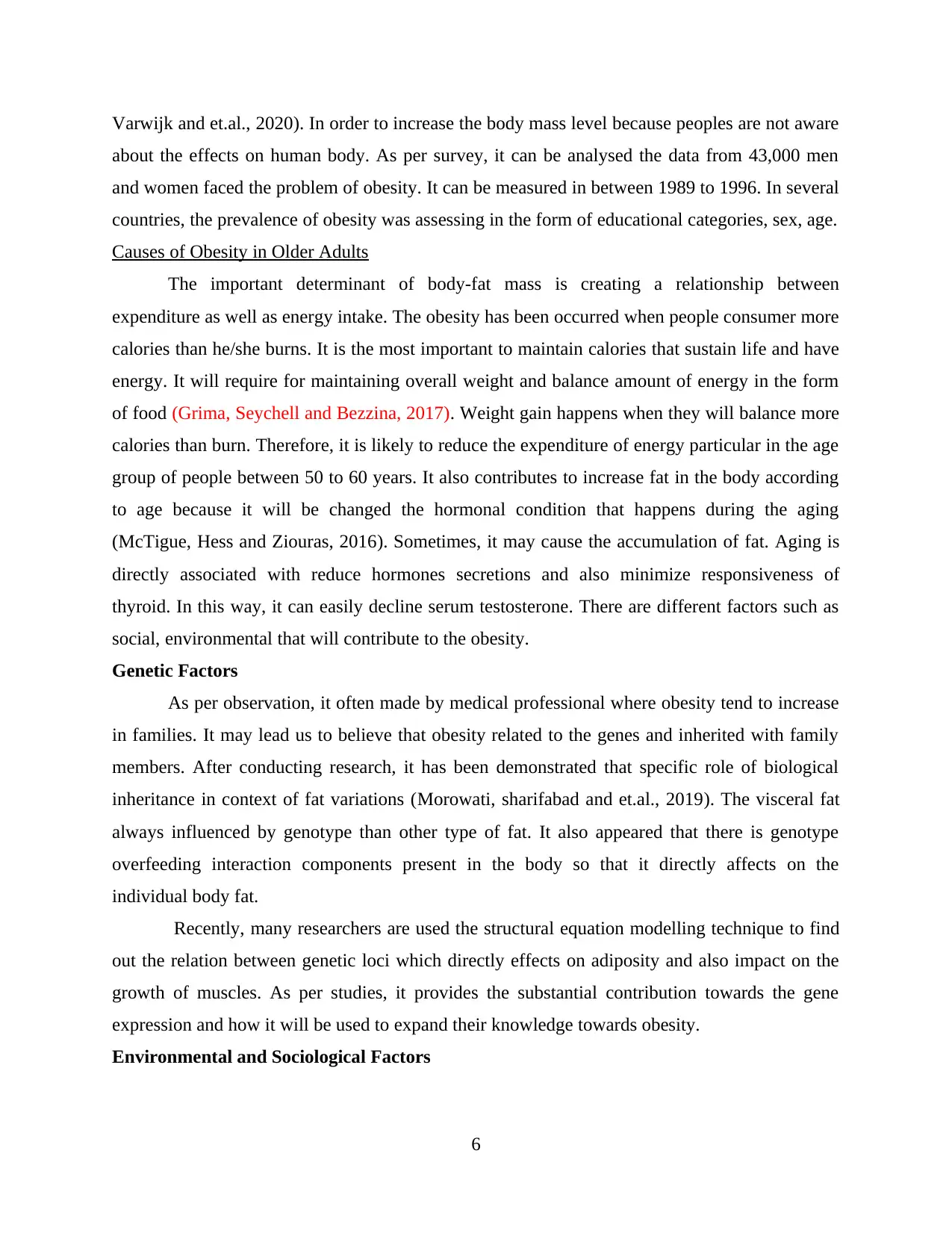
Varwijk and et.al., 2020). In order to increase the body mass level because peoples are not aware
about the effects on human body. As per survey, it can be analysed the data from 43,000 men
and women faced the problem of obesity. It can be measured in between 1989 to 1996. In several
countries, the prevalence of obesity was assessing in the form of educational categories, sex, age.
Causes of Obesity in Older Adults
The important determinant of body-fat mass is creating a relationship between
expenditure as well as energy intake. The obesity has been occurred when people consumer more
calories than he/she burns. It is the most important to maintain calories that sustain life and have
energy. It will require for maintaining overall weight and balance amount of energy in the form
of food (Grima, Seychell and Bezzina, 2017). Weight gain happens when they will balance more
calories than burn. Therefore, it is likely to reduce the expenditure of energy particular in the age
group of people between 50 to 60 years. It also contributes to increase fat in the body according
to age because it will be changed the hormonal condition that happens during the aging
(McTigue, Hess and Ziouras, 2016). Sometimes, it may cause the accumulation of fat. Aging is
directly associated with reduce hormones secretions and also minimize responsiveness of
thyroid. In this way, it can easily decline serum testosterone. There are different factors such as
social, environmental that will contribute to the obesity.
Genetic Factors
As per observation, it often made by medical professional where obesity tend to increase
in families. It may lead us to believe that obesity related to the genes and inherited with family
members. After conducting research, it has been demonstrated that specific role of biological
inheritance in context of fat variations (Morowati, sharifabad and et.al., 2019). The visceral fat
always influenced by genotype than other type of fat. It also appeared that there is genotype
overfeeding interaction components present in the body so that it directly affects on the
individual body fat.
Recently, many researchers are used the structural equation modelling technique to find
out the relation between genetic loci which directly effects on adiposity and also impact on the
growth of muscles. As per studies, it provides the substantial contribution towards the gene
expression and how it will be used to expand their knowledge towards obesity.
Environmental and Sociological Factors
6
about the effects on human body. As per survey, it can be analysed the data from 43,000 men
and women faced the problem of obesity. It can be measured in between 1989 to 1996. In several
countries, the prevalence of obesity was assessing in the form of educational categories, sex, age.
Causes of Obesity in Older Adults
The important determinant of body-fat mass is creating a relationship between
expenditure as well as energy intake. The obesity has been occurred when people consumer more
calories than he/she burns. It is the most important to maintain calories that sustain life and have
energy. It will require for maintaining overall weight and balance amount of energy in the form
of food (Grima, Seychell and Bezzina, 2017). Weight gain happens when they will balance more
calories than burn. Therefore, it is likely to reduce the expenditure of energy particular in the age
group of people between 50 to 60 years. It also contributes to increase fat in the body according
to age because it will be changed the hormonal condition that happens during the aging
(McTigue, Hess and Ziouras, 2016). Sometimes, it may cause the accumulation of fat. Aging is
directly associated with reduce hormones secretions and also minimize responsiveness of
thyroid. In this way, it can easily decline serum testosterone. There are different factors such as
social, environmental that will contribute to the obesity.
Genetic Factors
As per observation, it often made by medical professional where obesity tend to increase
in families. It may lead us to believe that obesity related to the genes and inherited with family
members. After conducting research, it has been demonstrated that specific role of biological
inheritance in context of fat variations (Morowati, sharifabad and et.al., 2019). The visceral fat
always influenced by genotype than other type of fat. It also appeared that there is genotype
overfeeding interaction components present in the body so that it directly affects on the
individual body fat.
Recently, many researchers are used the structural equation modelling technique to find
out the relation between genetic loci which directly effects on adiposity and also impact on the
growth of muscles. As per studies, it provides the substantial contribution towards the gene
expression and how it will be used to expand their knowledge towards obesity.
Environmental and Sociological Factors
6
⊘ This is a preview!⊘
Do you want full access?
Subscribe today to unlock all pages.

Trusted by 1+ million students worldwide
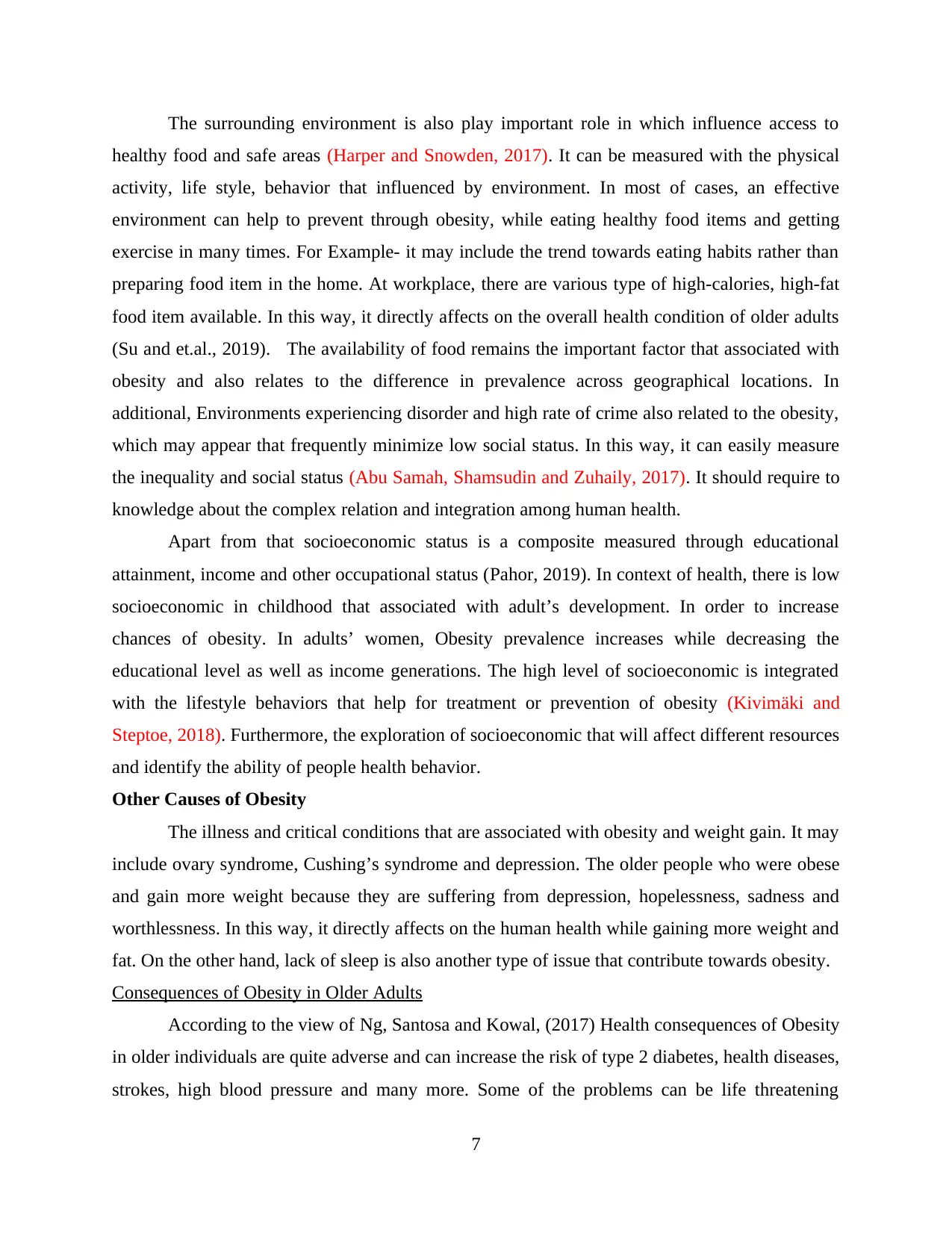
The surrounding environment is also play important role in which influence access to
healthy food and safe areas (Harper and Snowden, 2017). It can be measured with the physical
activity, life style, behavior that influenced by environment. In most of cases, an effective
environment can help to prevent through obesity, while eating healthy food items and getting
exercise in many times. For Example- it may include the trend towards eating habits rather than
preparing food item in the home. At workplace, there are various type of high-calories, high-fat
food item available. In this way, it directly affects on the overall health condition of older adults
(Su and et.al., 2019). The availability of food remains the important factor that associated with
obesity and also relates to the difference in prevalence across geographical locations. In
additional, Environments experiencing disorder and high rate of crime also related to the obesity,
which may appear that frequently minimize low social status. In this way, it can easily measure
the inequality and social status (Abu Samah, Shamsudin and Zuhaily, 2017). It should require to
knowledge about the complex relation and integration among human health.
Apart from that socioeconomic status is a composite measured through educational
attainment, income and other occupational status (Pahor, 2019). In context of health, there is low
socioeconomic in childhood that associated with adult’s development. In order to increase
chances of obesity. In adults’ women, Obesity prevalence increases while decreasing the
educational level as well as income generations. The high level of socioeconomic is integrated
with the lifestyle behaviors that help for treatment or prevention of obesity (Kivimäki and
Steptoe, 2018). Furthermore, the exploration of socioeconomic that will affect different resources
and identify the ability of people health behavior.
Other Causes of Obesity
The illness and critical conditions that are associated with obesity and weight gain. It may
include ovary syndrome, Cushing’s syndrome and depression. The older people who were obese
and gain more weight because they are suffering from depression, hopelessness, sadness and
worthlessness. In this way, it directly affects on the human health while gaining more weight and
fat. On the other hand, lack of sleep is also another type of issue that contribute towards obesity.
Consequences of Obesity in Older Adults
According to the view of Ng, Santosa and Kowal, (2017) Health consequences of Obesity
in older individuals are quite adverse and can increase the risk of type 2 diabetes, health diseases,
strokes, high blood pressure and many more. Some of the problems can be life threatening
7
healthy food and safe areas (Harper and Snowden, 2017). It can be measured with the physical
activity, life style, behavior that influenced by environment. In most of cases, an effective
environment can help to prevent through obesity, while eating healthy food items and getting
exercise in many times. For Example- it may include the trend towards eating habits rather than
preparing food item in the home. At workplace, there are various type of high-calories, high-fat
food item available. In this way, it directly affects on the overall health condition of older adults
(Su and et.al., 2019). The availability of food remains the important factor that associated with
obesity and also relates to the difference in prevalence across geographical locations. In
additional, Environments experiencing disorder and high rate of crime also related to the obesity,
which may appear that frequently minimize low social status. In this way, it can easily measure
the inequality and social status (Abu Samah, Shamsudin and Zuhaily, 2017). It should require to
knowledge about the complex relation and integration among human health.
Apart from that socioeconomic status is a composite measured through educational
attainment, income and other occupational status (Pahor, 2019). In context of health, there is low
socioeconomic in childhood that associated with adult’s development. In order to increase
chances of obesity. In adults’ women, Obesity prevalence increases while decreasing the
educational level as well as income generations. The high level of socioeconomic is integrated
with the lifestyle behaviors that help for treatment or prevention of obesity (Kivimäki and
Steptoe, 2018). Furthermore, the exploration of socioeconomic that will affect different resources
and identify the ability of people health behavior.
Other Causes of Obesity
The illness and critical conditions that are associated with obesity and weight gain. It may
include ovary syndrome, Cushing’s syndrome and depression. The older people who were obese
and gain more weight because they are suffering from depression, hopelessness, sadness and
worthlessness. In this way, it directly affects on the human health while gaining more weight and
fat. On the other hand, lack of sleep is also another type of issue that contribute towards obesity.
Consequences of Obesity in Older Adults
According to the view of Ng, Santosa and Kowal, (2017) Health consequences of Obesity
in older individuals are quite adverse and can increase the risk of type 2 diabetes, health diseases,
strokes, high blood pressure and many more. Some of the problems can be life threatening
7
Paraphrase This Document
Need a fresh take? Get an instant paraphrase of this document with our AI Paraphraser
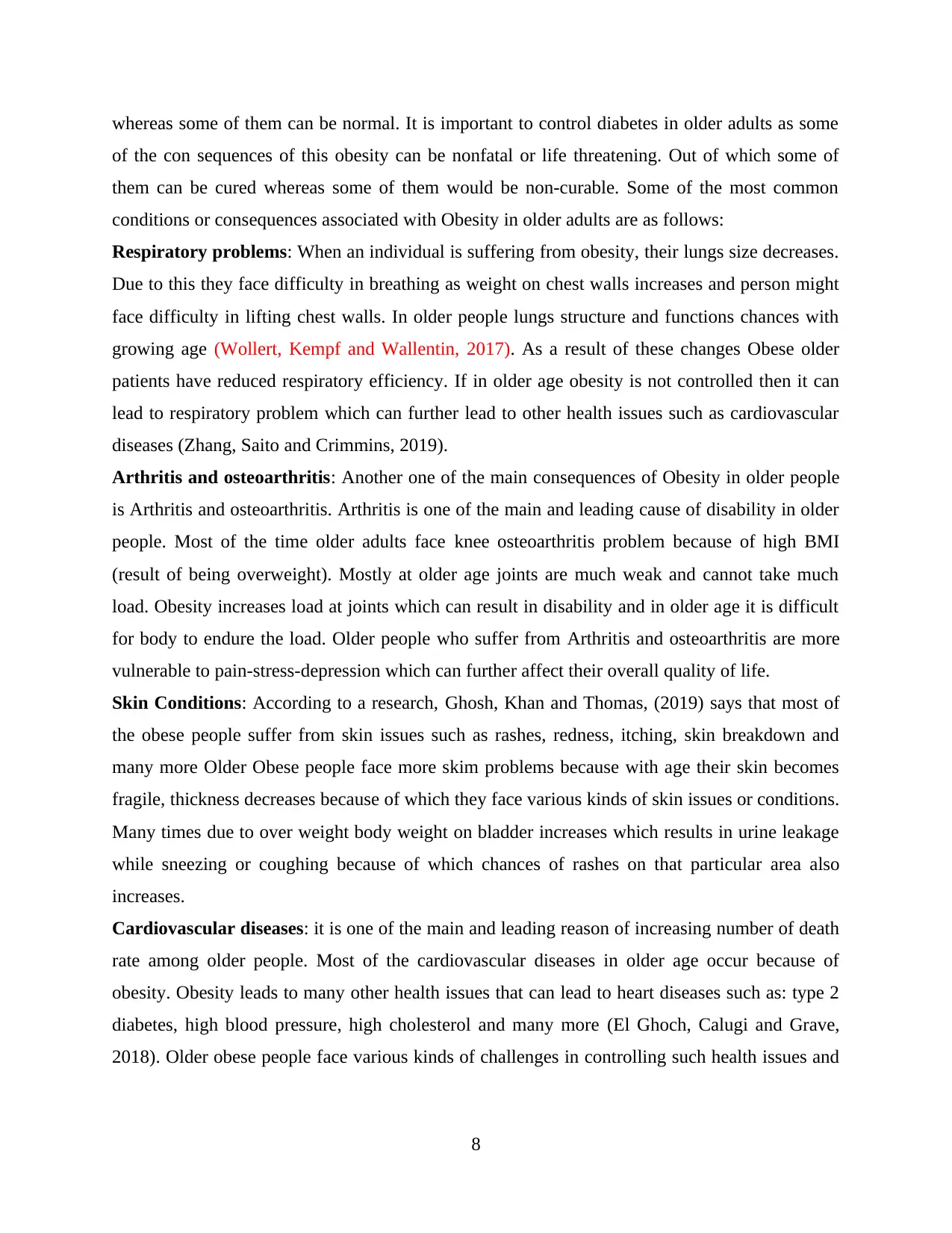
whereas some of them can be normal. It is important to control diabetes in older adults as some
of the con sequences of this obesity can be nonfatal or life threatening. Out of which some of
them can be cured whereas some of them would be non-curable. Some of the most common
conditions or consequences associated with Obesity in older adults are as follows:
Respiratory problems: When an individual is suffering from obesity, their lungs size decreases.
Due to this they face difficulty in breathing as weight on chest walls increases and person might
face difficulty in lifting chest walls. In older people lungs structure and functions chances with
growing age (Wollert, Kempf and Wallentin, 2017). As a result of these changes Obese older
patients have reduced respiratory efficiency. If in older age obesity is not controlled then it can
lead to respiratory problem which can further lead to other health issues such as cardiovascular
diseases (Zhang, Saito and Crimmins, 2019).
Arthritis and osteoarthritis: Another one of the main consequences of Obesity in older people
is Arthritis and osteoarthritis. Arthritis is one of the main and leading cause of disability in older
people. Most of the time older adults face knee osteoarthritis problem because of high BMI
(result of being overweight). Mostly at older age joints are much weak and cannot take much
load. Obesity increases load at joints which can result in disability and in older age it is difficult
for body to endure the load. Older people who suffer from Arthritis and osteoarthritis are more
vulnerable to pain-stress-depression which can further affect their overall quality of life.
Skin Conditions: According to a research, Ghosh, Khan and Thomas, (2019) says that most of
the obese people suffer from skin issues such as rashes, redness, itching, skin breakdown and
many more Older Obese people face more skim problems because with age their skin becomes
fragile, thickness decreases because of which they face various kinds of skin issues or conditions.
Many times due to over weight body weight on bladder increases which results in urine leakage
while sneezing or coughing because of which chances of rashes on that particular area also
increases.
Cardiovascular diseases: it is one of the main and leading reason of increasing number of death
rate among older people. Most of the cardiovascular diseases in older age occur because of
obesity. Obesity leads to many other health issues that can lead to heart diseases such as: type 2
diabetes, high blood pressure, high cholesterol and many more (El Ghoch, Calugi and Grave,
2018). Older obese people face various kinds of challenges in controlling such health issues and
8
of the con sequences of this obesity can be nonfatal or life threatening. Out of which some of
them can be cured whereas some of them would be non-curable. Some of the most common
conditions or consequences associated with Obesity in older adults are as follows:
Respiratory problems: When an individual is suffering from obesity, their lungs size decreases.
Due to this they face difficulty in breathing as weight on chest walls increases and person might
face difficulty in lifting chest walls. In older people lungs structure and functions chances with
growing age (Wollert, Kempf and Wallentin, 2017). As a result of these changes Obese older
patients have reduced respiratory efficiency. If in older age obesity is not controlled then it can
lead to respiratory problem which can further lead to other health issues such as cardiovascular
diseases (Zhang, Saito and Crimmins, 2019).
Arthritis and osteoarthritis: Another one of the main consequences of Obesity in older people
is Arthritis and osteoarthritis. Arthritis is one of the main and leading cause of disability in older
people. Most of the time older adults face knee osteoarthritis problem because of high BMI
(result of being overweight). Mostly at older age joints are much weak and cannot take much
load. Obesity increases load at joints which can result in disability and in older age it is difficult
for body to endure the load. Older people who suffer from Arthritis and osteoarthritis are more
vulnerable to pain-stress-depression which can further affect their overall quality of life.
Skin Conditions: According to a research, Ghosh, Khan and Thomas, (2019) says that most of
the obese people suffer from skin issues such as rashes, redness, itching, skin breakdown and
many more Older Obese people face more skim problems because with age their skin becomes
fragile, thickness decreases because of which they face various kinds of skin issues or conditions.
Many times due to over weight body weight on bladder increases which results in urine leakage
while sneezing or coughing because of which chances of rashes on that particular area also
increases.
Cardiovascular diseases: it is one of the main and leading reason of increasing number of death
rate among older people. Most of the cardiovascular diseases in older age occur because of
obesity. Obesity leads to many other health issues that can lead to heart diseases such as: type 2
diabetes, high blood pressure, high cholesterol and many more (El Ghoch, Calugi and Grave,
2018). Older obese people face various kinds of challenges in controlling such health issues and
8
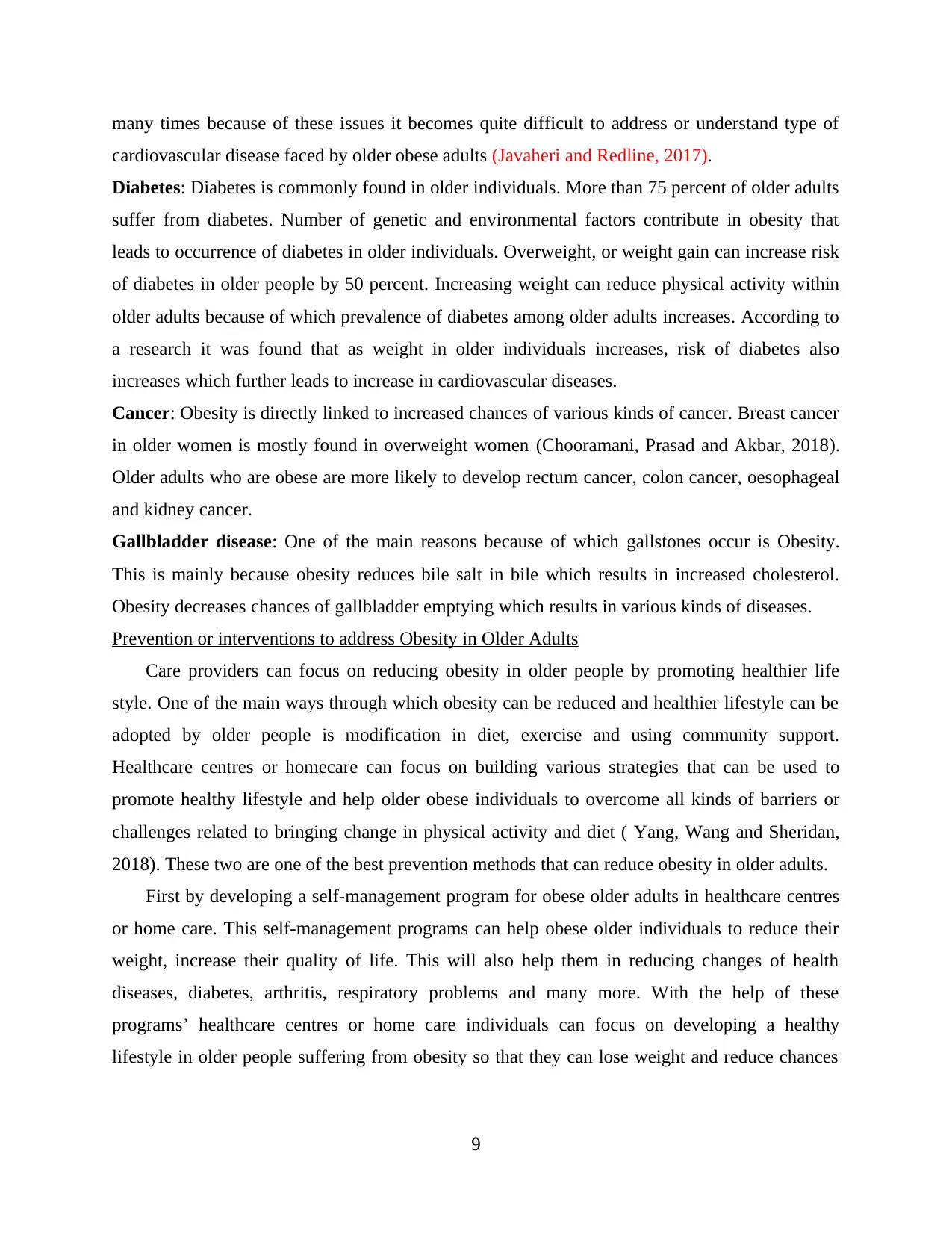
many times because of these issues it becomes quite difficult to address or understand type of
cardiovascular disease faced by older obese adults (Javaheri and Redline, 2017).
Diabetes: Diabetes is commonly found in older individuals. More than 75 percent of older adults
suffer from diabetes. Number of genetic and environmental factors contribute in obesity that
leads to occurrence of diabetes in older individuals. Overweight, or weight gain can increase risk
of diabetes in older people by 50 percent. Increasing weight can reduce physical activity within
older adults because of which prevalence of diabetes among older adults increases. According to
a research it was found that as weight in older individuals increases, risk of diabetes also
increases which further leads to increase in cardiovascular diseases.
Cancer: Obesity is directly linked to increased chances of various kinds of cancer. Breast cancer
in older women is mostly found in overweight women (Chooramani, Prasad and Akbar, 2018).
Older adults who are obese are more likely to develop rectum cancer, colon cancer, oesophageal
and kidney cancer.
Gallbladder disease: One of the main reasons because of which gallstones occur is Obesity.
This is mainly because obesity reduces bile salt in bile which results in increased cholesterol.
Obesity decreases chances of gallbladder emptying which results in various kinds of diseases.
Prevention or interventions to address Obesity in Older Adults
Care providers can focus on reducing obesity in older people by promoting healthier life
style. One of the main ways through which obesity can be reduced and healthier lifestyle can be
adopted by older people is modification in diet, exercise and using community support.
Healthcare centres or homecare can focus on building various strategies that can be used to
promote healthy lifestyle and help older obese individuals to overcome all kinds of barriers or
challenges related to bringing change in physical activity and diet ( Yang, Wang and Sheridan,
2018). These two are one of the best prevention methods that can reduce obesity in older adults.
First by developing a self-management program for obese older adults in healthcare centres
or home care. This self-management programs can help obese older individuals to reduce their
weight, increase their quality of life. This will also help them in reducing changes of health
diseases, diabetes, arthritis, respiratory problems and many more. With the help of these
programs’ healthcare centres or home care individuals can focus on developing a healthy
lifestyle in older people suffering from obesity so that they can lose weight and reduce chances
9
cardiovascular disease faced by older obese adults (Javaheri and Redline, 2017).
Diabetes: Diabetes is commonly found in older individuals. More than 75 percent of older adults
suffer from diabetes. Number of genetic and environmental factors contribute in obesity that
leads to occurrence of diabetes in older individuals. Overweight, or weight gain can increase risk
of diabetes in older people by 50 percent. Increasing weight can reduce physical activity within
older adults because of which prevalence of diabetes among older adults increases. According to
a research it was found that as weight in older individuals increases, risk of diabetes also
increases which further leads to increase in cardiovascular diseases.
Cancer: Obesity is directly linked to increased chances of various kinds of cancer. Breast cancer
in older women is mostly found in overweight women (Chooramani, Prasad and Akbar, 2018).
Older adults who are obese are more likely to develop rectum cancer, colon cancer, oesophageal
and kidney cancer.
Gallbladder disease: One of the main reasons because of which gallstones occur is Obesity.
This is mainly because obesity reduces bile salt in bile which results in increased cholesterol.
Obesity decreases chances of gallbladder emptying which results in various kinds of diseases.
Prevention or interventions to address Obesity in Older Adults
Care providers can focus on reducing obesity in older people by promoting healthier life
style. One of the main ways through which obesity can be reduced and healthier lifestyle can be
adopted by older people is modification in diet, exercise and using community support.
Healthcare centres or homecare can focus on building various strategies that can be used to
promote healthy lifestyle and help older obese individuals to overcome all kinds of barriers or
challenges related to bringing change in physical activity and diet ( Yang, Wang and Sheridan,
2018). These two are one of the best prevention methods that can reduce obesity in older adults.
First by developing a self-management program for obese older adults in healthcare centres
or home care. This self-management programs can help obese older individuals to reduce their
weight, increase their quality of life. This will also help them in reducing changes of health
diseases, diabetes, arthritis, respiratory problems and many more. With the help of these
programs’ healthcare centres or home care individuals can focus on developing a healthy
lifestyle in older people suffering from obesity so that they can lose weight and reduce chances
9
⊘ This is a preview!⊘
Do you want full access?
Subscribe today to unlock all pages.

Trusted by 1+ million students worldwide
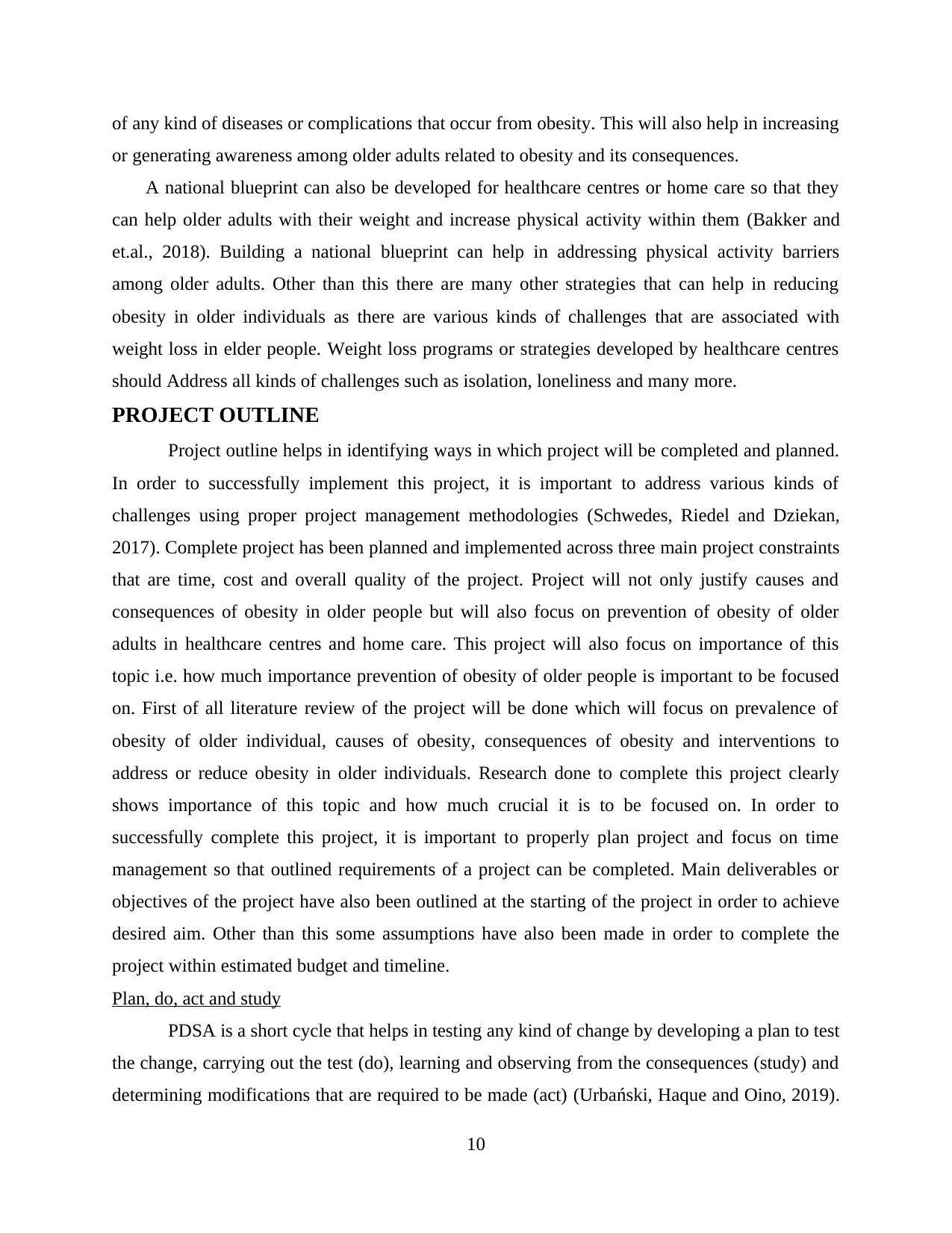
of any kind of diseases or complications that occur from obesity. This will also help in increasing
or generating awareness among older adults related to obesity and its consequences.
A national blueprint can also be developed for healthcare centres or home care so that they
can help older adults with their weight and increase physical activity within them (Bakker and
et.al., 2018). Building a national blueprint can help in addressing physical activity barriers
among older adults. Other than this there are many other strategies that can help in reducing
obesity in older individuals as there are various kinds of challenges that are associated with
weight loss in elder people. Weight loss programs or strategies developed by healthcare centres
should Address all kinds of challenges such as isolation, loneliness and many more.
PROJECT OUTLINE
Project outline helps in identifying ways in which project will be completed and planned.
In order to successfully implement this project, it is important to address various kinds of
challenges using proper project management methodologies (Schwedes, Riedel and Dziekan,
2017). Complete project has been planned and implemented across three main project constraints
that are time, cost and overall quality of the project. Project will not only justify causes and
consequences of obesity in older people but will also focus on prevention of obesity of older
adults in healthcare centres and home care. This project will also focus on importance of this
topic i.e. how much importance prevention of obesity of older people is important to be focused
on. First of all literature review of the project will be done which will focus on prevalence of
obesity of older individual, causes of obesity, consequences of obesity and interventions to
address or reduce obesity in older individuals. Research done to complete this project clearly
shows importance of this topic and how much crucial it is to be focused on. In order to
successfully complete this project, it is important to properly plan project and focus on time
management so that outlined requirements of a project can be completed. Main deliverables or
objectives of the project have also been outlined at the starting of the project in order to achieve
desired aim. Other than this some assumptions have also been made in order to complete the
project within estimated budget and timeline.
Plan, do, act and study
PDSA is a short cycle that helps in testing any kind of change by developing a plan to test
the change, carrying out the test (do), learning and observing from the consequences (study) and
determining modifications that are required to be made (act) (Urbański, Haque and Oino, 2019).
10
or generating awareness among older adults related to obesity and its consequences.
A national blueprint can also be developed for healthcare centres or home care so that they
can help older adults with their weight and increase physical activity within them (Bakker and
et.al., 2018). Building a national blueprint can help in addressing physical activity barriers
among older adults. Other than this there are many other strategies that can help in reducing
obesity in older individuals as there are various kinds of challenges that are associated with
weight loss in elder people. Weight loss programs or strategies developed by healthcare centres
should Address all kinds of challenges such as isolation, loneliness and many more.
PROJECT OUTLINE
Project outline helps in identifying ways in which project will be completed and planned.
In order to successfully implement this project, it is important to address various kinds of
challenges using proper project management methodologies (Schwedes, Riedel and Dziekan,
2017). Complete project has been planned and implemented across three main project constraints
that are time, cost and overall quality of the project. Project will not only justify causes and
consequences of obesity in older people but will also focus on prevention of obesity of older
adults in healthcare centres and home care. This project will also focus on importance of this
topic i.e. how much importance prevention of obesity of older people is important to be focused
on. First of all literature review of the project will be done which will focus on prevalence of
obesity of older individual, causes of obesity, consequences of obesity and interventions to
address or reduce obesity in older individuals. Research done to complete this project clearly
shows importance of this topic and how much crucial it is to be focused on. In order to
successfully complete this project, it is important to properly plan project and focus on time
management so that outlined requirements of a project can be completed. Main deliverables or
objectives of the project have also been outlined at the starting of the project in order to achieve
desired aim. Other than this some assumptions have also been made in order to complete the
project within estimated budget and timeline.
Plan, do, act and study
PDSA is a short cycle that helps in testing any kind of change by developing a plan to test
the change, carrying out the test (do), learning and observing from the consequences (study) and
determining modifications that are required to be made (act) (Urbański, Haque and Oino, 2019).
10
Paraphrase This Document
Need a fresh take? Get an instant paraphrase of this document with our AI Paraphraser
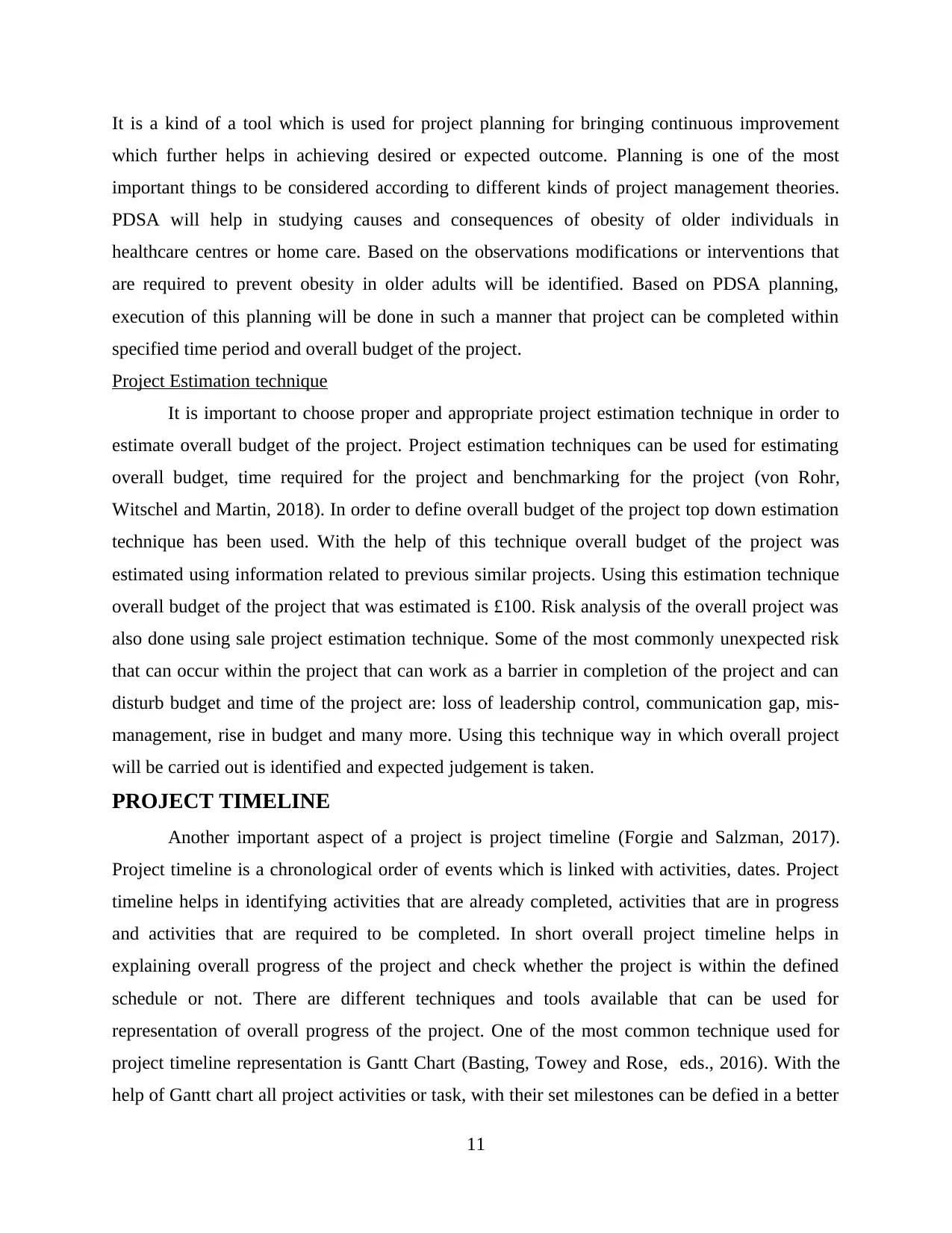
It is a kind of a tool which is used for project planning for bringing continuous improvement
which further helps in achieving desired or expected outcome. Planning is one of the most
important things to be considered according to different kinds of project management theories.
PDSA will help in studying causes and consequences of obesity of older individuals in
healthcare centres or home care. Based on the observations modifications or interventions that
are required to prevent obesity in older adults will be identified. Based on PDSA planning,
execution of this planning will be done in such a manner that project can be completed within
specified time period and overall budget of the project.
Project Estimation technique
It is important to choose proper and appropriate project estimation technique in order to
estimate overall budget of the project. Project estimation techniques can be used for estimating
overall budget, time required for the project and benchmarking for the project (von Rohr,
Witschel and Martin, 2018). In order to define overall budget of the project top down estimation
technique has been used. With the help of this technique overall budget of the project was
estimated using information related to previous similar projects. Using this estimation technique
overall budget of the project that was estimated is £100. Risk analysis of the overall project was
also done using sale project estimation technique. Some of the most commonly unexpected risk
that can occur within the project that can work as a barrier in completion of the project and can
disturb budget and time of the project are: loss of leadership control, communication gap, mis-
management, rise in budget and many more. Using this technique way in which overall project
will be carried out is identified and expected judgement is taken.
PROJECT TIMELINE
Another important aspect of a project is project timeline (Forgie and Salzman, 2017).
Project timeline is a chronological order of events which is linked with activities, dates. Project
timeline helps in identifying activities that are already completed, activities that are in progress
and activities that are required to be completed. In short overall project timeline helps in
explaining overall progress of the project and check whether the project is within the defined
schedule or not. There are different techniques and tools available that can be used for
representation of overall progress of the project. One of the most common technique used for
project timeline representation is Gantt Chart (Basting, Towey and Rose, eds., 2016). With the
help of Gantt chart all project activities or task, with their set milestones can be defied in a better
11
which further helps in achieving desired or expected outcome. Planning is one of the most
important things to be considered according to different kinds of project management theories.
PDSA will help in studying causes and consequences of obesity of older individuals in
healthcare centres or home care. Based on the observations modifications or interventions that
are required to prevent obesity in older adults will be identified. Based on PDSA planning,
execution of this planning will be done in such a manner that project can be completed within
specified time period and overall budget of the project.
Project Estimation technique
It is important to choose proper and appropriate project estimation technique in order to
estimate overall budget of the project. Project estimation techniques can be used for estimating
overall budget, time required for the project and benchmarking for the project (von Rohr,
Witschel and Martin, 2018). In order to define overall budget of the project top down estimation
technique has been used. With the help of this technique overall budget of the project was
estimated using information related to previous similar projects. Using this estimation technique
overall budget of the project that was estimated is £100. Risk analysis of the overall project was
also done using sale project estimation technique. Some of the most commonly unexpected risk
that can occur within the project that can work as a barrier in completion of the project and can
disturb budget and time of the project are: loss of leadership control, communication gap, mis-
management, rise in budget and many more. Using this technique way in which overall project
will be carried out is identified and expected judgement is taken.
PROJECT TIMELINE
Another important aspect of a project is project timeline (Forgie and Salzman, 2017).
Project timeline is a chronological order of events which is linked with activities, dates. Project
timeline helps in identifying activities that are already completed, activities that are in progress
and activities that are required to be completed. In short overall project timeline helps in
explaining overall progress of the project and check whether the project is within the defined
schedule or not. There are different techniques and tools available that can be used for
representation of overall progress of the project. One of the most common technique used for
project timeline representation is Gantt Chart (Basting, Towey and Rose, eds., 2016). With the
help of Gantt chart all project activities or task, with their set milestones can be defied in a better
11
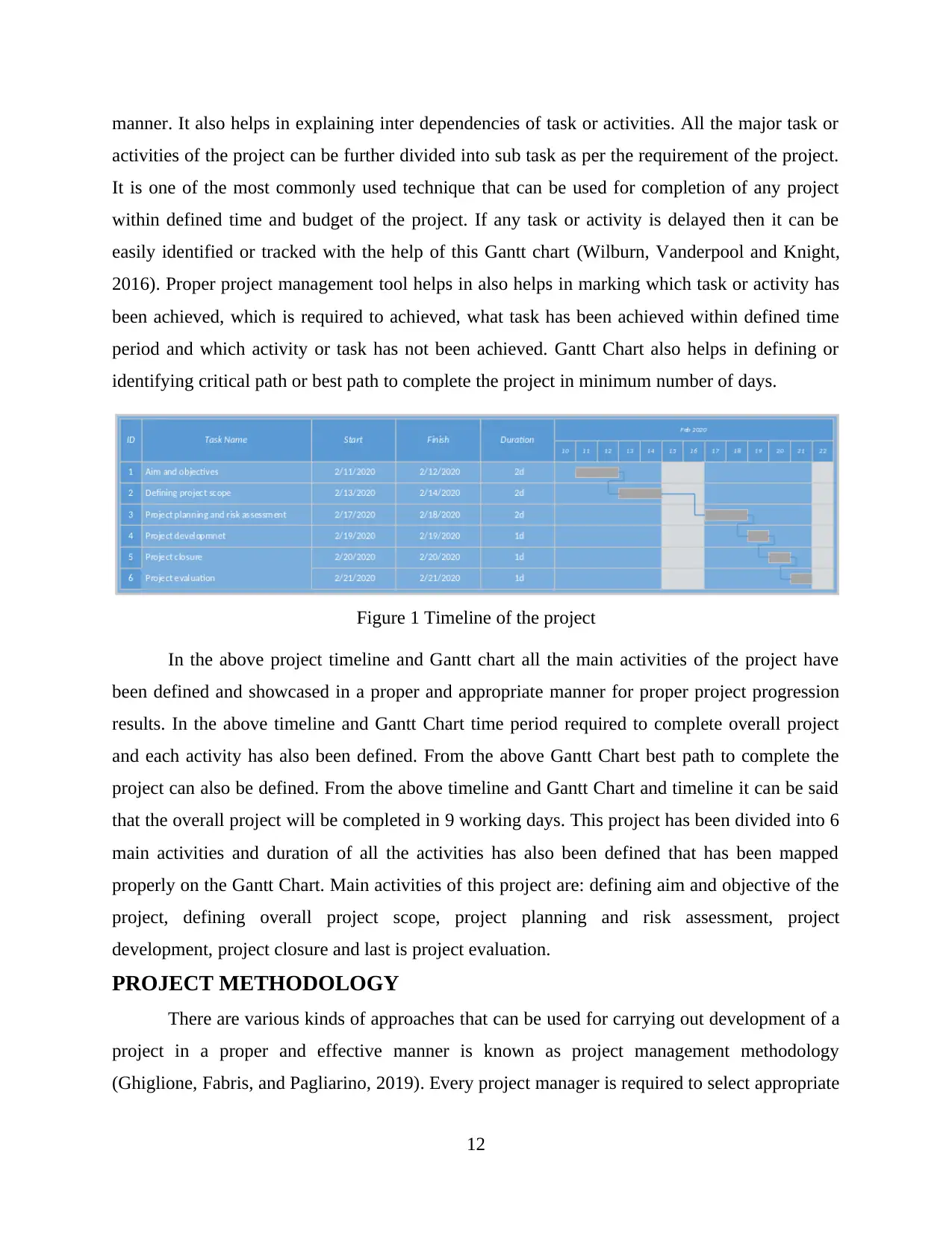
manner. It also helps in explaining inter dependencies of task or activities. All the major task or
activities of the project can be further divided into sub task as per the requirement of the project.
It is one of the most commonly used technique that can be used for completion of any project
within defined time and budget of the project. If any task or activity is delayed then it can be
easily identified or tracked with the help of this Gantt chart (Wilburn, Vanderpool and Knight,
2016). Proper project management tool helps in also helps in marking which task or activity has
been achieved, which is required to achieved, what task has been achieved within defined time
period and which activity or task has not been achieved. Gantt Chart also helps in defining or
identifying critical path or best path to complete the project in minimum number of days.
Figure 1 Timeline of the project
In the above project timeline and Gantt chart all the main activities of the project have
been defined and showcased in a proper and appropriate manner for proper project progression
results. In the above timeline and Gantt Chart time period required to complete overall project
and each activity has also been defined. From the above Gantt Chart best path to complete the
project can also be defined. From the above timeline and Gantt Chart and timeline it can be said
that the overall project will be completed in 9 working days. This project has been divided into 6
main activities and duration of all the activities has also been defined that has been mapped
properly on the Gantt Chart. Main activities of this project are: defining aim and objective of the
project, defining overall project scope, project planning and risk assessment, project
development, project closure and last is project evaluation.
PROJECT METHODOLOGY
There are various kinds of approaches that can be used for carrying out development of a
project in a proper and effective manner is known as project management methodology
(Ghiglione, Fabris, and Pagliarino, 2019). Every project manager is required to select appropriate
12
activities of the project can be further divided into sub task as per the requirement of the project.
It is one of the most commonly used technique that can be used for completion of any project
within defined time and budget of the project. If any task or activity is delayed then it can be
easily identified or tracked with the help of this Gantt chart (Wilburn, Vanderpool and Knight,
2016). Proper project management tool helps in also helps in marking which task or activity has
been achieved, which is required to achieved, what task has been achieved within defined time
period and which activity or task has not been achieved. Gantt Chart also helps in defining or
identifying critical path or best path to complete the project in minimum number of days.
Figure 1 Timeline of the project
In the above project timeline and Gantt chart all the main activities of the project have
been defined and showcased in a proper and appropriate manner for proper project progression
results. In the above timeline and Gantt Chart time period required to complete overall project
and each activity has also been defined. From the above Gantt Chart best path to complete the
project can also be defined. From the above timeline and Gantt Chart and timeline it can be said
that the overall project will be completed in 9 working days. This project has been divided into 6
main activities and duration of all the activities has also been defined that has been mapped
properly on the Gantt Chart. Main activities of this project are: defining aim and objective of the
project, defining overall project scope, project planning and risk assessment, project
development, project closure and last is project evaluation.
PROJECT METHODOLOGY
There are various kinds of approaches that can be used for carrying out development of a
project in a proper and effective manner is known as project management methodology
(Ghiglione, Fabris, and Pagliarino, 2019). Every project manager is required to select appropriate
12
⊘ This is a preview!⊘
Do you want full access?
Subscribe today to unlock all pages.

Trusted by 1+ million students worldwide
1 out of 23
Related Documents
Your All-in-One AI-Powered Toolkit for Academic Success.
+13062052269
info@desklib.com
Available 24*7 on WhatsApp / Email
![[object Object]](/_next/static/media/star-bottom.7253800d.svg)
Unlock your academic potential
Copyright © 2020–2025 A2Z Services. All Rights Reserved. Developed and managed by ZUCOL.



